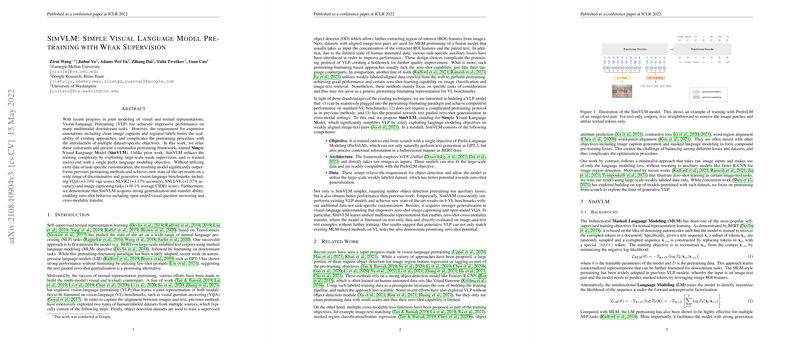Overview of SimVLM: Simple Visual LLM Pretraining with Weak Supervision
The paper "SimVLM: Simple Visual LLM Pretraining with Weak Supervision" presents a novel approach to vision-language pretraining (VLP) that emphasizes simplicity and scalability by leveraging weak supervision. Unlike traditional methods that require expensive annotations and burdensome pretraining protocols, SimVLM achieves strong performance across a diverse range of multimodal benchmarks using a minimalist framework.
Key Contributions
SimVLM introduces several innovations that collectively enhance VLP:
- Unified Objective with Prefix LLMing: The model utilizes a single pretraining objective—Prefix LLMing (PrefixLM)—that unifies the bidirectional context understanding capability of BERT and the generative strengths of GPT-3. This is a departure from existing approaches that often require multiple dataset-specific objectives and auxiliary losses to capture visual-linguistic alignment.
- Simplified Architecture: The architecture of SimVLM integrates Vision Transformer (ViT) / CoAtNet, utilizing raw image patches rather than preprocessed features from object detection models like Faster R-CNN. This not only simplifies the pretraining pipeline but also scales more effectively with larger datasets.
- Leveraging Weakly Supervised Data: By pretraining on large-scale weakly labeled image-text pairs from web sources and supplementing with text-only corpora, SimVLM capitalizes on the vast quantity of readily available data. This strategy significantly reduces the dependency on costly, human-annotated datasets.
Empirical Results
SimVLM demonstrates remarkable performance on multiple vision-language benchmarks, including Visual Question Answering (VQA), NLVR2, and SNLI-VE. The model outperforms state-of-the-art methods, achieving substantial gains in accuracy:
- VQA: +3.74% (vqa-score)
- NLVR2: +1.17% (accuracy)
- SNLI-VE: +1.37% (accuracy)
- Image Captioning: +10.1% (average CIDEr score)
Such strong numerical results highlight the efficacy of SimVLM's minimalist pretraining framework.
Theoretical and Practical Implications
The theoretical implications of this work are significant. By streamlining the pretraining process and reducing reliance on annotated data, SimVLM establishes that effective multimodal learning can be achieved with simpler, more scalable methodologies. This minimalistic approach opens new avenues in VLP research, suggesting that the essential elements of vision-language understanding may be captured without intricate and cumbersome protocols.
From a practical standpoint, SimVLM's ability to produce state-of-the-art results with minimal customization underscores its potential for widespread adoption. It equips researchers and practitioners with a powerful tool for deploying robust multimodal systems in real-world scenarios without the overhead of extensive data annotation and complex model configurations.
Speculations on Future Developments
Future developments in AI, particularly in the domain of vision-language interaction, could build upon the principles introduced by SimVLM. As the field progresses, it is plausible that:
- Generative VLP Models: There will be increased exploration of generative models for VLP further emphasizing the importance of unified objectives akin to PrefixLM for different data modalities.
- Edge Cases and Long-Tail Data: Enhancing zero-shot and few-shot learning capabilities may become focal areas, leveraging weak supervision from even noisier and more diverse data sources.
- Cross-Domain Transfer: Future models might extend SimVLM’s cross-modality transfer abilities, enabling seamless transitions between vastly different tasks, modalities, or even languages, thereby reflecting true general intelligence.
Conclusion
SimVLM represents a paradigm shift in vision-language pretraining by emphasizing a simplified, scalable approach with weak supervision. Its strong numerical performance, both on traditional benchmarks and in zero-shot settings, demonstrates the viability of minimalistic pretraining frameworks. The paper's findings suggest that the future of VLP lies in leveraging simplicity and vast, diverse data sources to achieve robust, generalizable AI systems.
